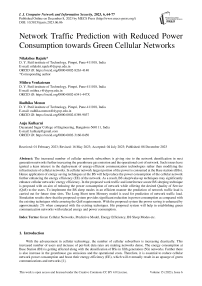Network Traffic Prediction with Reduced Power Consumption towards Green Cellular Networks
Автор: Nilakshee Rajule, Mithra Venkatesan, Radhika Menon, Anju Kulkarni
Журнал: International Journal of Computer Network and Information Security @ijcnis
Статья в выпуске: 6 vol.15, 2023 года.
Бесплатный доступ
The increased number of cellular network subscribers is giving rise to the network densification in next generation networks further increasing the greenhouse gas emission and the operational cost of network. Such issues have ignited a keen interest in the deployment of energy-efficient communication technologies rather than modifying the infrastructure of cellular networks. In cellular network largest portion of the power is consumed at the Base stations (BSs). Hence application of energy saving techniques at the BS will help reduce the power consumption of the cellular network further enhancing the energy efficiency (EE) of the network. As a result, BS sleep/wake-up techniques may significantly enhance cellular networks' energy efficiency. In the proposed work traffic and interference aware BS sleeping technique is proposed with an aim of reducing the power consumption of network while offering the desired Quality of Service (QoS) to the users. To implement the BS sleep modes in an efficient manner the prediction of network traffic load is carried out for future time slots. The Long Short term Memory model is used for prediction of network traffic load. Simulation results show that the proposed system provides significant reduction in power consumption as compared with the existing techniques while assuring the QoS requirements. With the proposed system the power saving is enhanced by approximately 2% when compared with the existing techniques. His proposed system will help in establishing green communication networks with reduced energy and power consumption.
Green Cellular Networks, Predictive Model, Energy Efficiency, BS Sleep Modes etc
Короткий адрес: https://sciup.org/15018811
IDR: 15018811 | DOI: 10.5815/ijcnis.2023.06.06
Текст научной статьи Network Traffic Prediction with Reduced Power Consumption towards Green Cellular Networks
With the advancement in cellular technology, the number of cellular subscribers is increasing drastically. This increased number of users and increase of per-link data rates are making networks dense. The energy consumption at Base Station (BS) is getting affected along with the densification of BSs in fifth generation (5G) networks. Further there is also increase in the greenhouse gas emissions and the operational costs. Therefore, it is essential to reduce cellular network power consumption and boost their energy-efficiency (EE), which will eventually result in an upsurge of green communications and networks [1].
The primary aim of such networks is to minimize the total energy consumption with least capacity deprivation. This is accomplished by addressing every network component, including UE energy efficiency optimization, battery life extension, and the development of green data protocols that are tailored to the operation of central data units. However, the BSs, which account for around 80% of the total demand in cellular networks, are the largest source of energy usage [2].
The various approaches for energy-efficiency are 1) Utilization of renewable energy sources 2) modifications in existing architecture 3) cell management techniques etc. The energy-efficient methods based on the first two categories are more particularly investigating energy-efficient network topologies employing renewable energy sources and energyefficient considerations for signal models or hardware specifications. This is due to the fact that the majority of the resources and components employed in the current architecture of the cellular network do not correspond to the expectations for energy efficiency and affordability. These strategies, however, often require significant hardware and infrastructure modifications, therefore network operators have to carefully assess the operational and monetary aspects before any modifications [3]. Unlike the first two approaches, cell-management techniques do not require extreme modifications to the network infrastructure, hence such cell management techniques incur low implementation costs which is an advantage over the other approaches. Typically, the power is conserved by turning off or turning on certain cell components such the air conditioning system, power amplifier units, signal processing and control units, or the whole BS. Additionally, as cellular networks have grown denser and more diverse, ranging managing the EE of BSs become even more difficult. Thus, a real-time implementation of the BS scheduling is important which considers traffic characteristics. Though the energy efficiency is significantly enhanced through e a sleep/wake-up scheduling scheme; there is a possibility of large-scale network outage or low capacity affecting Quality of Service (QoS), hence adaption of specific remedial solutions becomes necessary [4].
2. Related Works
The survey of existing literature is divided into two categories 1) prediction techniques used for network traffic prediction and 2) BS sleeping techniques for reducing power consumption at BS.
In the first part survey of cellular network traffic prediction techniques is presented. A comparative study of various multi-task learning frameworks is presented in [5] to identify the Spatio-temporal correlation among base stations. Qiu et al. have concluded that significant information can be obtained by BSs in order to improve prediction accuracy. A graphbased learning approach is used for the prediction of cellular traffic [6]. Jaffry et al. have proposed work [7] the traffic prediction is carried out using Auto Regressive Integrated Moving Average (ARIMA), Feed Forward Neural Network (FFNN), and Recurrent Neural Networks (RNN). The results show that FFNN and RNN perform better than ARIMA and the training time taken by RNN is less than the FFNN model. Azari et al. [8] carried out the experimentation on ARIMA and Long Short-Term Memory (LSTM) model for cellular network traffic prediction and classification. A real-time traffic dataset is used for the comparative study and the results show that the LSTM performs better than ARIMA when the length of the training dataset is large.
Paper [9,10] presented short-term traffic forecasting using the LSTM model. Qiao et al.[9] presented a parallel LSTM model for short-term traffic flow forecasting and explored the short-term and periodic characteristics of the network traffic using the parallel LSTM model. Zhaowei et al.[10] authors proposed the M-B-LSTM model. Authors constructed an online self-learning network to learn and equalize the traffic flow statistic distribution for reducing the effect of distribution imbalance and overfitting problems during network learning. Further authors proposed a deep bi-directional LSTM model to reduce the uncertainty problem.
It is found in the literature that the prediction techniques in literature are applied for the short-term prediction of network traffic. For the appropriate implementation of BS sleep modes, long-term prediction of traffic is very important; this is one of the gaps identified. In the proposed work, the long-term traffic prediction is being done and towards the same LSTM model has been used.
In the second part the existing work of BS sleep mode techniques is reviewed. The various approaches adapted for implementation of BS sleep modes are 1) Deployment of relay station, 2) Load sharing based approach, 3) learning based approach and 4) Designing the optimization problem.
The studies in [11,12] sought to lessen BS's significant contribution to the overall network's energy usage. The utility efficiency of green energy is increased by improving the user connection, according to B. Wang et al [11] attempts to reduce BS power consumption. By dividing the traffic burden, Han et al. [12] decreased the communication overhead between the user and the BS. The network's power usage was greatly decreased using the proposed solution.
By implementing BS sleep modes, papers [13,14] developed a learning-based and Markov Decision Process based strategy to reduce the power consumption of BS. Authors suggested adaptive BS sleep modes in [13] to lower BS's power usage. The authors recommended using reinforcement learning (RL) to build advanced sleep patterns. Femto-macro heterogeneous network architecture is taken into account in [14] for the implementation of BS sleep modes. To determine the best BS sleep technique, authors utilised an algorithm that is based on value iteration.
Designing the optimization issue for BS switching using different optimization approaches was the main focus of the studies in [15-18]. For BS switching, Gunhee Jang et al. [15] suggested optimising the BS sleep mode. The authors used an LSTM-based model to forecast user traffic for various time windows. This expected user traffic is used to design the BS sleep mode optimization problem. The optimization issue is resolved with further Lyapunov optimization. The trade-off between user performance and power consumption due to BS switching was examined by the authors in [16]. The load balancing user association approach is used to improve user performance. For the purpose of choosing the BS sleep mode, authors [17] presented a binary social spider algorithm. The optimization problem is formulated using a penalty function. An energy-saving plan was developed by the authors in [18]. The proposed research takes into account two categories of data traffic: high data traffic and low data traffic. To handle the two types of traffic, different data and control planes are used. Particle swarm optimization is used to address the optimization problem, which was created in order to save energy.
It has been observed that the existing literature does not discuss about the network traffic prediction for implementation of BS sleep modes. This is the gap identified by surveying the above papers, hence in the proposed work the network traffic load is predicted in order to decide the mode of BS (i.e. active or sleep), this incorporation of prediction will help in implementing the BS sleep modes in more efficient manner further reducing the power consumption of BS.
Hence, the main contributions of the paper are:
• Implementation of long-term prediction of network traffic load which is used as deciding factor for switching BS into sleep mode.
• Usage of two types of traffic variations i.e. uniform traffic variations and non-uniform traffic variations (where each cell may have a different call arrival rate or different traffic load).
• Implementation for each traffic variation three different case scenarios namely 1) standard scenario (All BSs on), 2) Traffic aware BS sleeping and Distance based BS selection and 3) Traffic aware BS sleeping and Interference based BS selection.
• Reduction of power consumption of BS using proposed traffic and interference aware BS switching system while maintaining the QoS.
3. Overview of Prediction Model3.1. Auto Regressive Integrated Moving Average
The remainder of the paper is organized as follows: User traffic prediction methods are covered in Section 3 while the proposed system is covered in Section 4. Results are discussed in Section 5, and Section 6 concludes the work.
In the proposed system the user traffic load prediction is carried out with three techniques. The first technique is an Autoregressive Integrated Moving Average which is a regression-based technique. Secondly, the Artificial Neural Network is used for user traffic load prediction. Subsequently, the Deep Learning model i.e. Long Short Term Memory is used for the prediction.
The first method which is considered in the proposed work is a statistical regression model i.e. Autoregressive integrated moving average (ARIMA). In ARIMA, the autoregressive term refers to lags of the stationary series, moving average term refers to lags of the forecast errors and differencing of time series in order to make it stationary. The ARIMA model is denoted as the ARIMA(p,d,q) model, where 'p' denotes the number of autoregressive terms in the series, 'q' the quantity of lagged forecast errors, and 'd' the differencing necessary for stationarity.
In the autoregression model, the variables of interest are forecasted using a linear combination of former values of the variables. Autoregressive models are well suited for time series analysis due to their flexibility in handling an extensive range of diverse time series patterns.
An autoregressive model of order p can be represented as,
y(t) = С + E t + ф 1 ££ -1 + ф 2 ££ -2 + •••. +Ф р ££ - 9 (1)
where е£: white noise
This is referred to as an autoregressive model of order p, an AR(p) model.
The moving average model uses past forecast errors instead of using past forecast values of the variables. The MA model is represented as,
-
У(0 = С + Ф 1 У £-1 + Ф 2 У £-2 + • . +ФрУ £-р + £ t (2)
-
3.2. ANN
This model is referred to as MA(q) model.
The p, d, and q decide the type of the ARIMA model such as random walk, autoregression, exponential smoothing, and moving average which are considered special cases of the ARIMA model.
ANNs are adaptable computational architectures that can model a variety of nonlinear issues. Although there are some heuristic guidelines for choosing the activation function, it is unclear if the performance of the networks is significantly impacted by various activation functions. The single hidden layer feedforward network is a popular tool for forecasting and modeling time series. A network of three layers of simple processing units connected by acyclic linkages defines the model. The relationship between the output yt and the inputs {x1,x2,x3........., xt} has the following mathematical representation:
Vt = do + Zj=i aj g{boj + Z^ bu yt-i] + St where, a, (j=0,1, 2, ...,q) and Ьц(i = 0,1, 2, ...,q; j = 1, 2, ...,q) are frequently referred to as the connection weights in models. The number of hidden nodes is q, while the number of input nodes is p. The logistic function is frequently used as the transfer function for hidden layers, f(x)=(1+exp(-x))-1.
Hence, the ANN model of (3) in fact performs a nonlinear functional mapping from the past observations { V t-i ,y t-2 ............, yt- p } to the future value yt , i.e.
where,
Vt=f{Vt-1,Vt-2............,yt-p,w } St where w is a vector of all parameters and f is a function determined by the network structure and connection weights.
3.3. Long Short Term Memory (LSTM)
4. Proposed System
A subtype of RNNs is a Long Short-Term Memory (LSTM) Network. LSTM models are used to overcome the longterm dependency problem since they can retain information for extended periods of time. The building blocks of an LSTM network are called LSTM units, and each LSTM unit has four gates: a cell, an output gate, an input gate, and a forget gate. A Cell stores the values of time series over arbitrary time intervals. The remaining 3 gates, known as the input, output, and forget gates, compute the activation function. They serve as controls on the flow of values across the neural network's connections. The inclusion of sequence gives the function being approximated a new dimension. The network is capable of learning a mapping function for the inputs over time to an output rather than just mapping inputs to outputs. The structure of the typical LSTM unit is shown in figure 1.
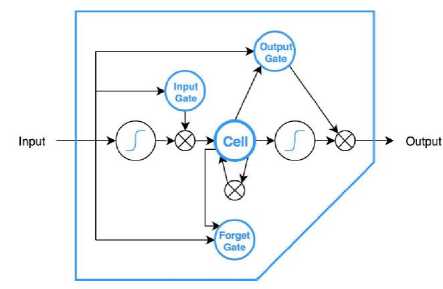
Fig.1. Structure of LSTM cell
The primary goal of the proposed system is to minimize the power consumption of BS while maintaining the QoS of communication. For minimizing the power consumption of BS sleep mode approach and for maintaining the QoS interference aware BS selection approach is adapted. The proposed approach can be divided into three sub problems 1) Initial association of user and BS, 2) BS sleeping approach and 3) BS selection approach. The BSs identify the user traffic load by getting the information from user traffic prediction module. Once the traffic load information is known for each BS, the proposed BS sleeping and BS selection algorithms can be applied to the BSs. The initial connection between user and BS is decided using initial user-BS association algorithm. The decision of switching a BS into sleep mode is taken based on the predicted traffic load; whenever any BS has traffic load below 30%, the BS is switched to sleep mode. Further the users of the BS which is switched to sleep mode are distributed among the neighbouring BSs; the selection of BS is done on the interference parameter. The proposed system is shown in figure 2.
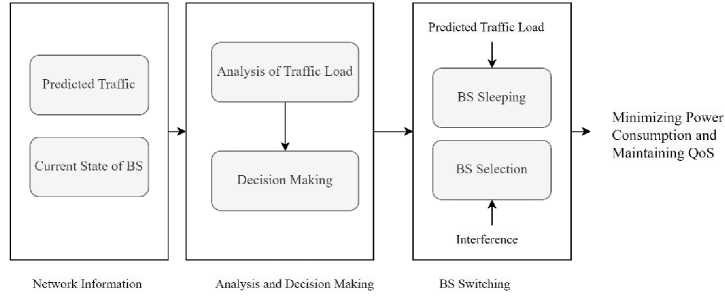
Fig.2. Proposed system
During the BS selection process users of the BS which is switched to sleep mode will search for neighbouring BSs and the information of interference level is obtained for each available BS. Among the available BSs; the BS with minimum interference is selected for connection. The interference aware BS selection process ensures the QoS to the users.
-
4.1. Initial User-BS Association
In the proposed system the initial association of users with BS is carried out using the distance parameter. The distance between each UE and BS is calculated using equation 3 and the user is connected to the BS with a minimum distance.
d =
(^ 1- ^ 2)
- (У 1- У 2/
The process of the association of users to the BS is presented in figure 3.
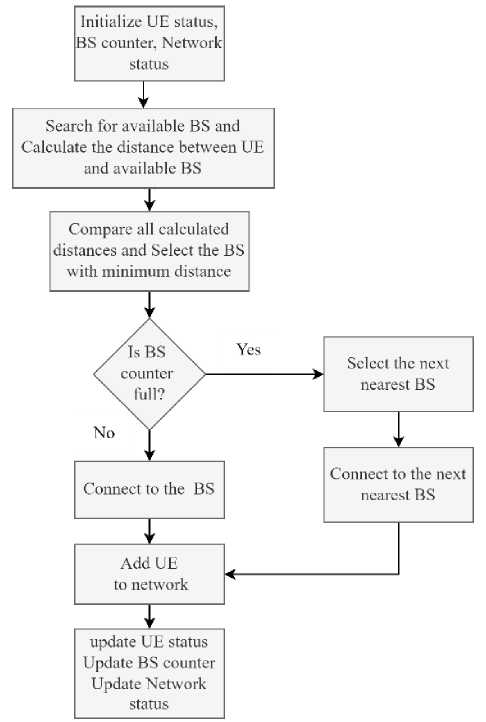
Fig.3. Process of user-BS initial association
-
4.2. BS Switching Case Scenarios
In the proposed work three case scenarios are presented; the proposed case scenarios are as follows:
Case Scenario 1:
This is the standard scenario wherein all the BSs in the network are always ON irrespective of the user traffic load of the BS.
Case Scenario 2:
This is the system which is implemented in existing work. In this case scenario the BS sleep modes are implemented but the prediction of the user traffic load in not carried out. Further users of the BS which are switched to sleep mode are connected to the nearest active BSs.
Case Scenario 3:
This scenario represents the proposed traffic and interference aware BS switching technique. This is the scenario which is novel and has not been explored in literature. The proposed system has been designed to reduce he power consumption while maintaining QoS. In the proposed scenario firstly the user traffic load per BS is predicted for future time slots and this predicted traffic load is used as the deciding factor for BS sleep mode selection. Further the users of BSs which are in sleep mode are connected to the neighboring BS which offers minimum interference. The interference between the user and BS is calculated using the equation 5.
h ,t = T- B^Bi” Ey^ P dl,b h iJ (6)
"6,t where Nbt is the total number of users associated with BS B during time slot t.
Pdlb is the transmitted power of BS B during downlink hy is the channel gain between the user I associated with BS B and BS B serving user j.
The proposed traffic and interference aware BS switching system reduces the power consumption of the network and also guarantees the better QoS. The parameter description is as follows:
UEb: Connection status of BS ‘b’ (UEb=ϕ: Connected or UEb≠ϕ: not connected)
-
I: Interference of BS.
CBS: Capacity of BS
Cmax= Maximum capacity of BS
Ti: Traffic load of BS ‘i’
Tth: Traffic load threshold
The complete system flow is presented in figure 4.
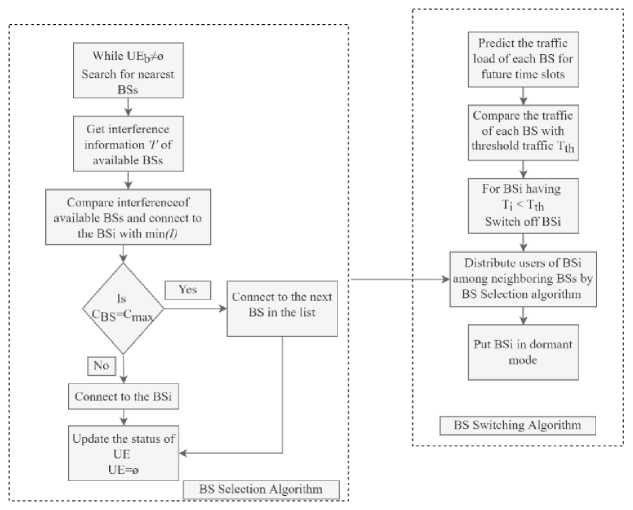
Fig.4. BS switching system
-
4.3. Power Consumption Model
Further the power consumption of the network is calculated as sum of power consumption of individual BSs in the network for a given time slot. The power consumption model is described by equations from 6-9.
P(Net) = Z n=1 (P(D + P(j-) switching' ) (7)
where,
P(0 = M ou (i) * (P / + p s * Pd (0) + M sl (f) * P / + M sb (i) * P^
P D (i) = P(i)max*X T=i d j *a iJ*-^ 4
S witching = ^ i=1(Xi * P sleep-standby + Yi * P on-sleep + Z i * P on-standby1 )
The terminology used in the equations as follows:
P(Net). Total Power Consumption of network
P(C): Power consumption of a BS
Switching : Switching Powe
M on : On mode
M sl : Sleep mode
M sb : Standby mode
P/: Fixed power consumption
ps: Slope of load dependent power consumption
PD: Load dependent power consumption
dj: Data traffic demand of user j.
a^: Connection between BS I and user j.
5. Simulation Results and Discussions5.1. Dataset Description
5.2. Results of ARIMA
C m ax: Maximum capacity of BS
P s l eep-s tandb y : Power consumption between sleep and standby mode switching
Pon-Sleep: Power consumption between sleep and on mode switching Pon-Standby: Power consumption between on and standby mode switching X i , Y, Z i : State transitions
In this section the results obtained from prediction model and BS switching technique are presented. In the prediction module, implementation of the predictive model is performed and the performance evaluation is measured through performance evaluation metric i.e. Root Mean Squared Error (RMSE) and performance evaluation of three prediction techniques is carried out.
The proposed model's dataset has been collected from Kaggle. The dataset contains data on 4G LTE cells' downlink traffic (measured in Kbps). For a year, 57 LTE cells are used to collect the data. The Root Mean Squared Error (RMSE) measure is used to assess the performance of various models.
For predicting the user traffic load ARIMA (0,1,1) model is used as there are no constants in the time series data. The forecast values with the 95% confidence intervals are shown in figure 5, where the red line indicates the forecast values for next 72 hours and the dotted1 lines indicate the 95% confidence intervals for those forecasts.
The RMSE plot of ARIMA model is shown in figure 6. The average RMSE offered by the ARIMA model is 603.21. Due to the rich multi-fractal behaviour (i.e. data is obtained from multiple sources) of cellular Internet traffic the linear regression model shows poor performance. From the results it is clear that linear time-series prediction algorithms like ARIMA seem to be affected by unwanted artifacts in the series
Hence to improve the network traffic forecasting the process is implemented using ANN.
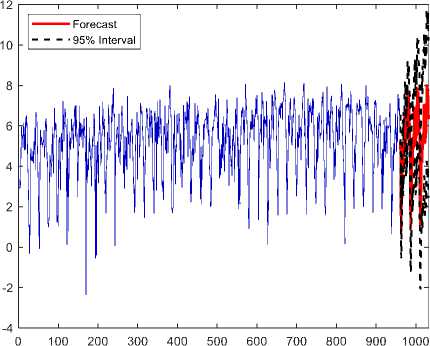
Fig.5. Forecast with 95% confidence interval using ARIMA (0,1,1) model
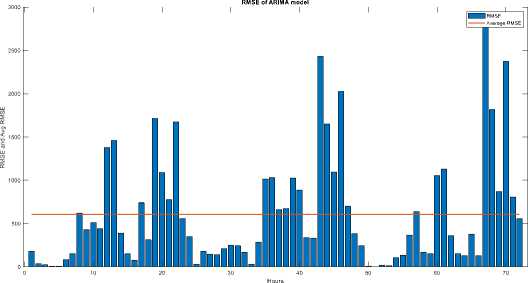
Fig.6. RMSE Plot of ARIMA (0,1,1)
-
5.3. Results of ANN
The model structure of the best predictive model, the ANN, which connects input and output data through hidden layers, is shown in Fig. 7. The method of computing output values based on independent variables that are decided by neurons in hidden layers and have varied weights and biases is shown in Figure 7.

Fig.7. Closed loop view of network
The performance of the ANN model is shown in figure 8. The plot has four lines, Train, Validation, test and Best (dotted line). The best performance is obtained if train, test and validation lines lie near best line and it is confirmed that the training has been done successfully. The model is run to obtain the best validation performance. The best validation performance is obtained at epoch 3 where the difference validation and best line is minimum.
Further the validation check is carried out in order to check the problems in dataset. Validation check error indicates the data set has some problem. The number of validation checks are 6 at epoch 9 after which the training will be stopped with trainscg function. Figure 9 shows the validation check of ANN model.
Regression analysis of data comprised of 80% training, 10% testing, and 10% validation is shown in figure 10; the corresponding values are noted in the figure. It is being assumed that accuracy of the predictive model as the regression is more.
Fig.8. Performance plot of ANN
Fig.9. Validation checks of ANN model
Best Validation Performance is 19683.2589 at epoch 3
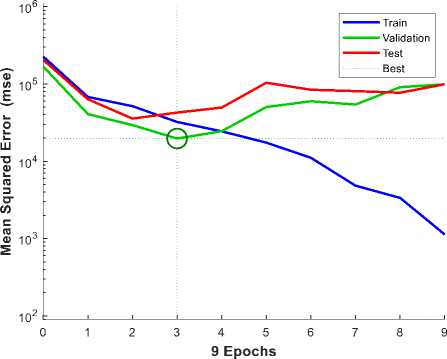
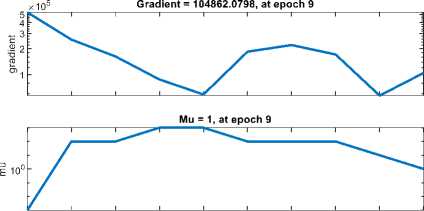
Validation Checks = 6, at epoch 9

9 Epochs
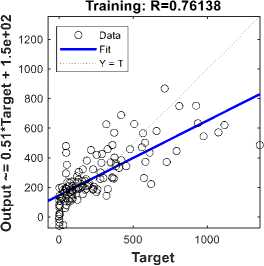
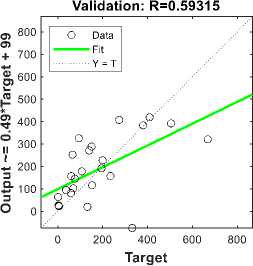
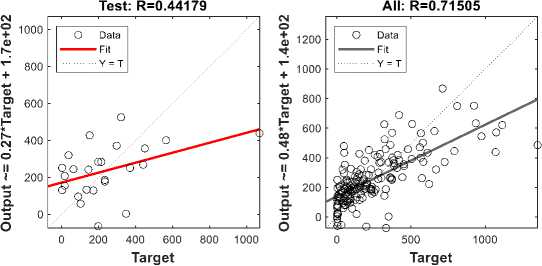
Fig.10. Regression plot of ANN
The regression plot of ANN indicates that the predicted plots represent an average fit, and also the best performance measure of the overall data set RMSE as 271.65. The results obtained with ANN model offers high RMSE as the data is irregular and do not show any specific pattern. Thus, there is need to incorporate more learning to the system in order to improve the prediction accuracy. Hence for the prediction of network traffic LSTM model which a type of Deep Learning is used. The results of LSTM model are presented in next section.
-
5.4. Results of LSTM Model
The hyper parameter selected for LSTM model are given in Table 1
Table 1. Hyper Parameter Selection
|
Total no. of Layers |
3 layers: 2 Input and 1 Output |
|
Hidden Units in Model |
500 |
|
Error Function used |
RMSE |
|
Algorithm used for Training |
Adaptive Moment Estimation |
|
Training Data Split Ratio (Training: Testing) |
70:30 |
|
Training Stop Rule |
After 300 epochs |
|
Minimum Batch Size |
50 |
The training plot of LSTM model is shown in figure 11. Adaptive Moment Estimation (ADAM) is used as training algorithm as the recursive structure of ADAM makes it easy to approximate extreme values of functions that can only be estimated by noisy observations and solve linear systems with noisy data. Adaptive Gradients and Root Mean Square Propagation are two random gradient descent techniques combined in ADAM. This optimization algorithm produces a stochastic approximation by using a subset of randomly chosen data instead of the complete data set to compute the actual gradient.
The training is carried out for 300 epochs and one iteration will be carried out for each epoch. The validation check is done after every 10 iterations. The validation RMSE obtained during training process is 9.215.
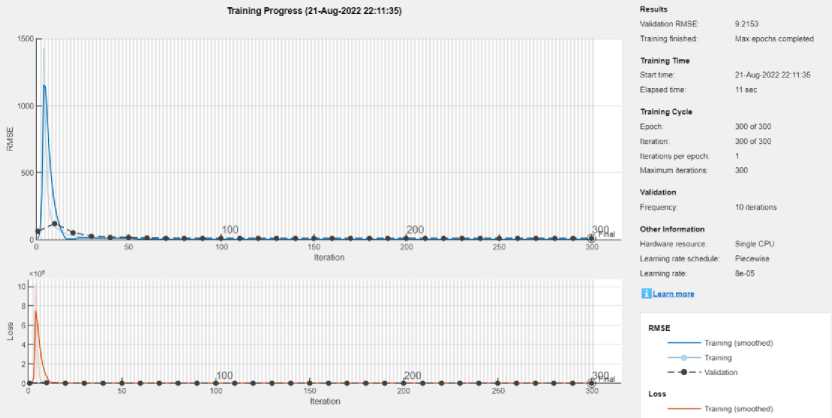
Fig.11. Training plot of LSTM
The RMSE plot of LSTM is shown in figure 12. The plot shows RMSE of prediction of 10 days. The average RMSE obtained with LSTM model is 68.
Among the three models the LSTM model performs better than the ARIMA and ANN model. The LSTM is capable of remembering values over arbitrary intervals; hence it is well suited for classification and prediction for given time series data of unknown size and time lags. Also, it can sustain with the highly irregular data as it is relatively less sensitive to such irregularity as compared to ARIMA and ANN models. The summary of the results of all three prediction models is given in table 2.
Further this predicted traffic load is provided to the BS switching system. This predicted traffic load is used as a criterion for switching BS to sleep mode. The experimentation is carried out on two types of traffic variation and for each type of traffic variation three case scenarios are presented and results of these case scenarios for each type of traffic variation are compared. The simulation is carried out on network consisting five BSs and the power consumption is calculated for 24 time slots.
Figure 13 shows the comparison of power consumption of 3 scenarios for uniform traffic variation.
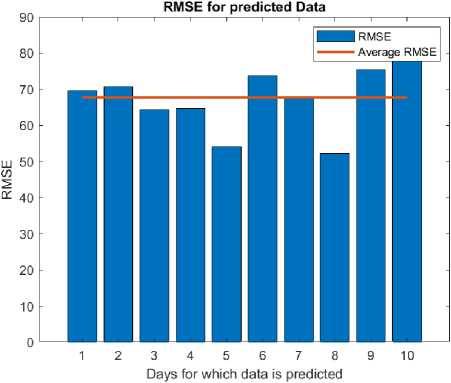
Fig.12. RMSE plot of LSTM model
Table 2. Comparison of RMSE
|
Sr. No. |
Prediction Model |
RMSE |
|
1 |
ARIMA |
603.21 |
|
2 |
ANN |
271.65 |
|
3 |
LSTM |
68 |
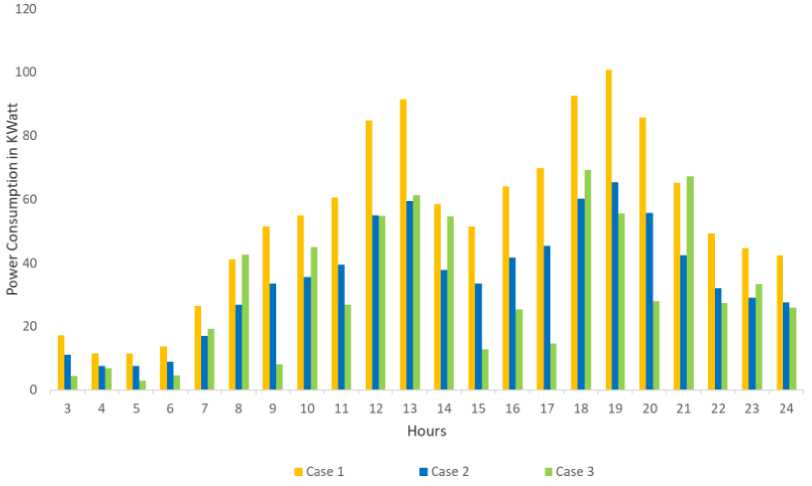
Fig.13. Comparison of power consumption for uniform traffic variation
The simulation is carried out on uniform traffic variations. Form figure it is seen that with proposed technique the power consumption of network is reduced as compared to the existing BS sleeping techniques. Figure 14 shows the comparison of power consumption for non-uniform traffic variations. From fig. 14 it is observed that the proposed system offers low power consumption as compared with the standard scenario and existing BS sleeping techniques. Also, it is clear that the proposed system works satisfactorily for non-uniform traffic variations.
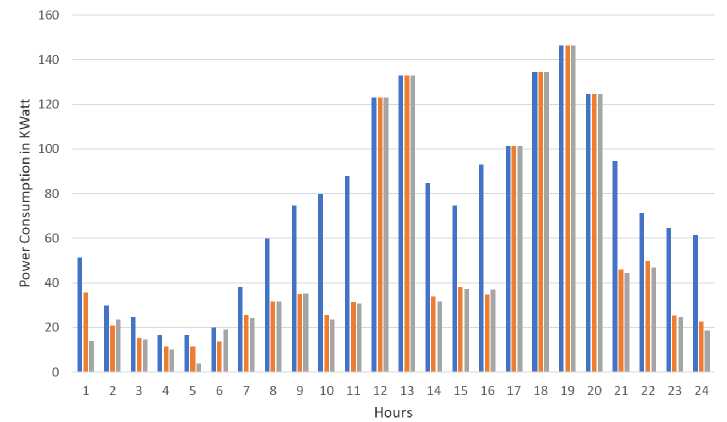
■ Case 1 ■ Case 2 ■ Case 3
Fig.14. Comparison of power consumption for non-uniform traffic variation
The comparative results are summarized in Table 3.
Table 3. Comparison of power consumption
|
Uniform Traffic Variation |
Non-Uniform Traffic Variation |
|||
|
Total Power Consumption (Kwatt) |
Power Saving (%) |
Total Power Consumption (Kwatt) |
Power Saving (%) |
|
|
Scenario 1 |
1244.88 |
- |
1806.6 |
- |
|
Scenario 2 |
854.11 |
30.11 |
1272.14 |
29.58 |
|
Scenario3 |
843.9 |
32.21 |
1233.92 |
31.70 |
From table 3 it is observed that 32.21% power is saved for uniform traffic variation and 31.70% power is saved in case of non-uniform traffic variations. When compared with the existing work, the power saving is enhanced by approximately 2%.
6. Conclusions
In the current era power saving of cellular networks has become an important aspect in order to enhance the energy efficiency of the networks. The maximum power is consumed by the BS in cellular networks. Hence in this paper a novel traffic and interference aware BS sleep mode technique is introduced to reduce the power consumption of BS .In the proposed system the prediction of network traffic load is carried out for implementing the BS sleep modes in an efficient manner. For traffic prediction the performance of three models (ARI, ANN, LSTM) have been compared. For evaluating the performance of these models RMSE metric is used. Results show that among the three models the LSTM model performs better than the ARIMA and ANN model. Further this predicted traffic load is provided to the proposed BS sleeping algorithm and the results are compared with the standard scenario and the techniques used in existing literature. Results show that 32.21% power is saved for uniform traffic variation and 31.70% power is saved in case of no-uniform traffic variations using the novel technique implemented. When compared with the existing work the power saving is enhanced by approximately 2%. Reduction in power consumption can have major impact in improving QoS and these techniques could lead to green communication. In future these techniques can be integrated with cell zooming technique to reduce the power consumption of BSs and enhance the energy efficiency of cellular networks. Prediction of cellular traffic load is also a promising solution for resource reservation and management.
Список литературы Network Traffic Prediction with Reduced Power Consumption towards Green Cellular Networks
- M. Masoudi et al., “Green Mobile Networks for 5G and beyond,” IEEE Access, vol. 7, pp. 107270–107299, 2019, doi: 10.1109/ACCESS.2019.2932777.
- H. Panahi, Fereidoun & H. Panahi, Farzad & Hattab, Ghaith & Ohtsuki, Tomoaki & Cabric, Danijela. (2018). Green Heterogeneous Networks via an Intelligent Sleep/Wake-Up Mechanism and D2D Communications. IEEE Transactions on Green Communications and Networking. PP. 1-1. 10.1109/TGCN.2018.2844301.
- Farooq, Junaid & Ghazzai, Hakim & Yaacoub, E. & Kadri, Abdullah & Alouini, Mohamed-Slim. (2017). Green Virtualization for Multiple Collaborative Cellular Operators. IEEE Transactions on Cognitive Communications and Networking. PP. 10.1109/TCCN.2017.2712133.
- Turgut, Esma & Gursoy, M. Cenk. (2017). Uplink Performance Analysis in D2D-Enabled mmWave Cellular Networks. 10.1109/VTCFall.2017.8288068.
- C. Qiu, Y. Zhang, Z. Feng, P. Zhang, and S. Cui, “Spatio-Temporal Wireless Traffic Prediction with Recurrent Neural Network,” IEEE Wireless Communications Letters, vol. 7, no. 4, pp. 554–557, Aug. 2018, doi: 10.1109/LWC.2018.2795605.
- Institute of Electrical and Electronics Engineers, 2017 IEEE 25th International Conference on Network Protocols (ICNP) : ICNP 2017 : proceedings : 10-13 October 2017, Toronto.
- S. Jaffry, “Cellular Traffic Prediction with Recurrent Neural Network,” Mar. 2020, [Online]. Available: http://arxiv.org/abs/2003.02807
- S. Qiao, R. Sun, G. Fan, and J. Liu, “Short-Term Traffic Flow Forecast Based on Parallel Long Short-Term Memory Neural Network.”
- A. Azari, P. Papapetrou, S. Denic, and G. Peters, “Cellular Traffic Prediction and Classification: A Comparative Evaluation of LSTM and ARIMA,” in Lecture Notes in Computer Science (including subseries Lecture Notes in Artificial Intelligence and Lecture Notes in Bioinformatics), 2019, vol. 11828 LNAI, pp. 129–144. doi: 10.1007/978-3-030-33778-0_11.
- Q. Zhaowei, L. Haitao, L. Zhihui, and Z. Tao, “Short-Term Traffic Flow Forecasting Method with M-B-LSTM Hybrid Network,” IEEE Transactions on Intelligent Transportation Systems, vol. 23, no. 1, pp. 225–235, Jan. 2022, doi: 10.1109/TITS.2020.3009725.
- Q. K. W. L. and L. T. Y. B. Wang, “On efficient utilization of green energy in heterogeneous cellular networks,” B. Wang, Q. Kong, W. Liu, and L. T. Yang.
- J. Wu, Y. Bao, G. Miao, S. Zhou, and Z. Niu, ‘‘Base-station sleeping control and power matching for energy–delay tradeoffs with bursty traffic,’’ IEEE Trans. Veh. Technol., vol. 65, no. 5, pp. 3657–3675, May 2016.
- M. Masoudi, M. G. Khafagy, E. Soroush, D. Giacomelli, S. Morosi and C. Cavdar, "Reinforcement Learning for Traffic-Adaptive Sleep Mode Management in 5G Networks," 2020 IEEE 31st Annual International Symposium on Personal, Indoor and Mobile Radio Communications, 2020, pp. 1-6, doi: 10.1109/PIMRC48278.2020.9217286.
- Jing Wu, Yun Li, Hongcheng Zhuang, Zhiwen Pan, Guoyin Wang, Yongju Xian, “SMDP-based sleep policy for base stations in heterogeneous cellular networks”, Digital Communications and Networks", Volume 7, Issue 1, 2021, Pages 120-130, ISSN 2352-8648, https://doi.org/10.1016/j.dcan.2020.04.010.
- G. Jang, N. Kim, T. Ha, C. Lee and S. Cho, "Base Station Switching and Sleep Mode Optimization With LSTM-Based User Prediction," in IEEE Access, vol. 8, pp. 222711-222723, 2020, doi: 10.1109/ACCESS.2020.3044242.
- Post, Bart & Borst, Sem & Berg, Hans. (2021). A self-organizing base station sleeping and user association strategy for dense cellular networks. Wireless Networks. 27. 1-16. 10.1007/s11276-020-02383-3.
- J. J. Q. Yu and V. O. K. Li, "Base station switching problem for green cellular networks with Social Spider Algorithm," 2014 IEEE Congress on Evolutionary Computation (CEC), 2014, pp. 2338-2344, doi: 10.1109/CEC.2014.6900235.
- Kang, M.W.; Chung, Y.W. An Efficient Energy Saving Scheme for Base Stations in 5G Networks with Separated Data and Control Planes Using Particle Swarm Optimization. Energies 2017, 10,1417. https://doi.org/10.3390/en10091417

